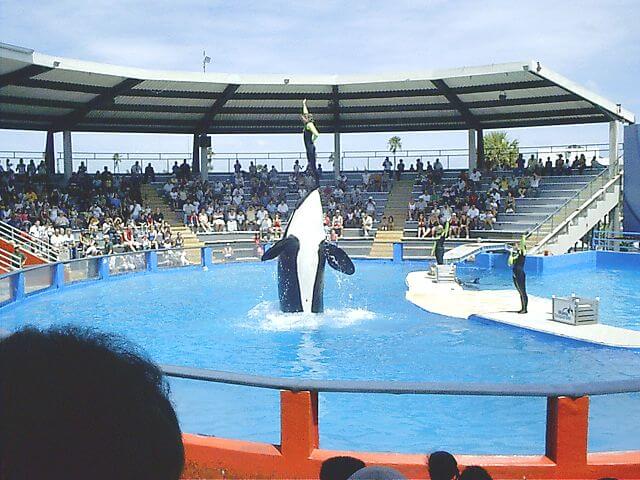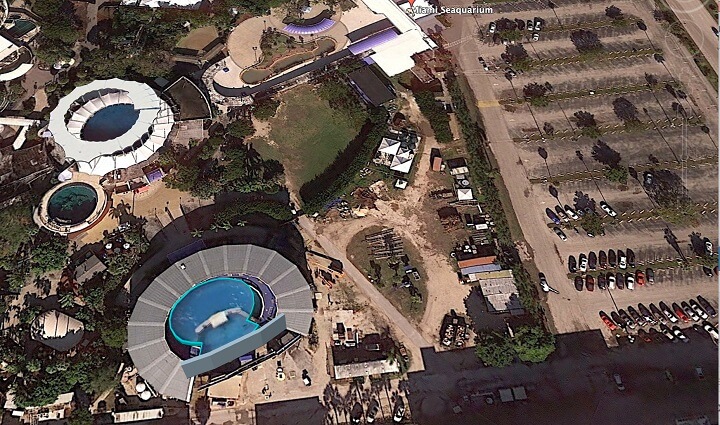At the request of, and under the guidance of, Lummi cultural advisors, experts from the Whale Sanctuary Project have developed a responsible operational plan to bring Sk’aliCh’elh-tenaut (“Lolita”) home from the Miami Seaquarium to her home in the Salish Sea, subject to all regulatory approvals and receipt of government permits.
July, 2021
In 1970, when she was just four years old, the orca known as Lolita became one of more than 80 whales captured from their families in their native Pacific waters for sale to the new marine entertainment park industry. Shortly after her capture, Lolita was sold to the Miami Seaquarium for about $20,000.
Since that time, the Lummi Nation of the Pacific Northwest have continued to press for her return. To the Lummi, she is not “Lolita”; she is Sk’aliCh’elh-tenaut, a member of Sk’aliCh’elh family of orcas who call the Salish Sea their home.

The orca “Lolita” balancing her trainer on her rostrum at the Miami Seaquarium – photo by Marc Averette, Creative Commons.

The Miami Seaquarium and its surrounds – photo by Marc Averette, Creative Commons.
Summary
As part of our Whale Aid work, the Whale Sanctuary Project has drafted a comprehensive operational plan, grounded in and guided by Lummi ancestral wisdom as well as science, to safely bring Sk’aliCh’elh-tenaut back to her Xwlemi Tokw (her home) in the Salish Sea, subject to all regulatory approvals and receipt of government permits.
The Xwlemi Tokw will be a secure and protected area within the Salish Sea where Sk’aliCh’elh-tenaut can thrive in her natal waters while receiving ongoing human care. The operational plan was created in consultation with leading experts in marine mammal veterinary medicine, rehabilitation and husbandry, the lives and culture of the Southern Resident orcas of the Pacific Northwest, and the Salish Sea ecosystem.
The operational plan addresses how to responsibly proceed with all components of Sk’aliCh’elh-tenaut’s return to her custom-built Xwlemi Tokw in the Salish Sea, while always prioritizing her wellbeing and the wellbeing of the Salish Sea ecosystem and all its inhabitants, including the Southern Resident orcas. These components include:
- A comprehensive evaluation of her physical and behavioral condition at the Miami Seaquarium by qualified experts. This evaluation plan includes a detailed review of Sk’aliCh’elh-tenaut’s history and records, as well as a thorough initial health evaluation and protocols for ongoing health and behavioral monitoring. This evaluation begins the process of ensuring that Sk’aliCh’elh-tenaut is free of any uncontrolled health concerns that could pose a threat to the Southern Resident orcas or Salish Sea ecosystem.
- A closely monitored conditioning plan prior to transport. This plan includes conditioning objectives specifically for the safe transport of Sk’aliCh’elh-tenaut and to facilitate her introduction to the Xwlemi Tokw. The plan includes specific health and behavioral criteria which Sk’aliCh’elh-tenaut must meet to be considered a candidate for safe transport home to the Salish Sea.
- A detailed transport plan addressing each leg of the transport from Sk’aliCh’elh-tenaut’s tank at the Miami Seaquarium to the Xwlemi Tokw. The transport plan includes step-by-step operational protocols, estimated timetables, and a comprehensive transport risk management plan addressing risks and outlining contingency plans for each stage of the transport.
- Protocols for Sk’aliCh’elh-tenaut’s on-site care once she has arrived at the Xwlemi Tokw. These protocols address her initial introduction to the habitat and the transitional phase of her acclimation, as well as her long-term ongoing care and the security of the Xwlemi Tokw.
- A detailed description of her Xwlemi Tokw, a secure and protected habitat in which to provide care to Sk’aliCh’elh-tenaut within her home waters of the Salish Sea. Her Xwlemi Tokw is designed to protect the wellbeing of Sk’aliCh’elh-tenaut, the Southern Resident orcas, and the Salish Sea ecosystem. Along with a description and design of her Xwlemi Tokw, this section contains detailed information on maintenance systems such as those used for net cleaning and repair as well as long-term environmental monitoring protocols. This site overview includes a comprehensive on-site risk management plan with protocols designed to safely address potential emergency situations such as those presented by a fire or tsunami. It also includes information on how on-site emergency equipment will contribute to increase community response capacity in emergencies, such as in the event of an oil spill in the area. The site development component of the operational plan is supported by appendices that outline an environmental analysis plan and review of national and local requirements for implementation of the project.
- A comprehensive review of potential ecological risks and mitigation strategies. This section thoroughly investigates the possible ecological risks of bringing Sk’aliCh’elh-tenaut home to the Xwlemi Tokw, evaluates their likelihood based on the best available science, presents effective mitigation strategies, and identifies gaps in knowledge where more data is needed.
Each component of the operational plan includes a detailed review of necessary equipment, personnel and security required for safe and responsible implementation. In addition to the operational plan, a detailed budget has been developed for each stage of the project.
Relevant cultural and spiritual considerations are interwoven into the fabric of the operational plan, which was created specifically for the Lummi-led effort to bring Sk’aliCh’elh-tenaut home to the Salish Sea.
See also:
Scarlet (J-50) and the Southern Resident Orcas
The joint effort to save an ailing, young Southern Resident orca.